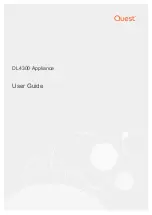
RAID 5 increases performance by supporting concurrent accesses to the multiple
DDMs within each logical volume. Data protection is provided by parity, which is
stored throughout the drives in the array. If a drive fails, the data on that drive can
be restored using all the other drives in the array along with the parity bits that
were created when the data was stored.
RAID 6 overview
RAID 6 is a method of increasing the data protection of arrays with volume data
spread across multiple disk drives. The DS8000 series supports RAID 6 arrays.
RAID 6 increases data protection by adding an extra layer of parity over the RAID
5 implementation. By adding this protection, RAID 6 can restore data from an
array with up to two failed drives. The calculation and storage of extra parity
slightly reduces the capacity and performance compared to a RAID 5 array. RAID
6 is suitable for storage using archive class DDMs.
RAID 10 overview
RAID 10 provides high availability by combining features of RAID 0 and RAID 1.
The DS8000 series supports RAID 10 arrays.
RAID 0 increases performance by striping volume data across multiple disk drives.
RAID 1 provides disk mirroring, which duplicates data between two disk drives.
By combining the features of RAID 0 and RAID 1, RAID 10 provides a second
optimization for fault tolerance.
RAID 10 implementation provides data mirroring from one DDM to another DDM.
RAID 10 stripes data across half of the disk drives in the RAID 10 configuration.
The other half of the array mirrors the first set of disk drives. Access to data is
preserved if one disk in each mirrored pair remains available. In some cases, RAID
10 offers faster data reads and writes than RAID 5 because it is not required to
manage parity. However, with half of the DDMs in the group used for data and
the other half used to mirror that data, RAID 10 disk groups have less capacity
than RAID 5 disk groups.
DS8000 Interfaces
This section describes the following interfaces:
v
IBM System Storage DS Storage Manager
v
IBM System Storage DS Command-Line Interface (CLI)
v
IBM System Storage DS Open application programming interface
v
IBM Tivoli Storage Productivity Center
v
IBM Tivoli Storage Productivity for Replication Manager
Note:
For DS8000, you can have a maximum of 256 interfaces of any type
connected at one time.
System Storage DS
®
Storage Manager
The DS Storage Manager is an interface that is used to perform logical
configurations and Copy Services management functions.
The DS Storage Manager can be accessed through the Tivoli Storage Productivity
Center Element Manager from any network-connected workstation with a
Chapter 2. Hardware and features
25
Summary of Contents for DS8700
Page 2: ......
Page 8: ...vi Introduction and Planning Guide...
Page 10: ...viii Introduction and Planning Guide...
Page 20: ...xviii Introduction and Planning Guide...
Page 22: ...xx Introduction and Planning Guide...
Page 44: ...22 Introduction and Planning Guide...
Page 142: ...120 Introduction and Planning Guide...
Page 160: ...138 Introduction and Planning Guide...
Page 212: ...190 Introduction and Planning Guide...
Page 218: ...196 Introduction and Planning Guide...
Page 224: ...202 Introduction and Planning Guide...
Page 242: ...220 Introduction and Planning Guide...
Page 254: ...232 Introduction and Planning Guide...
Page 255: ......
Page 256: ...Printed in USA GC27 2297 09...
















































